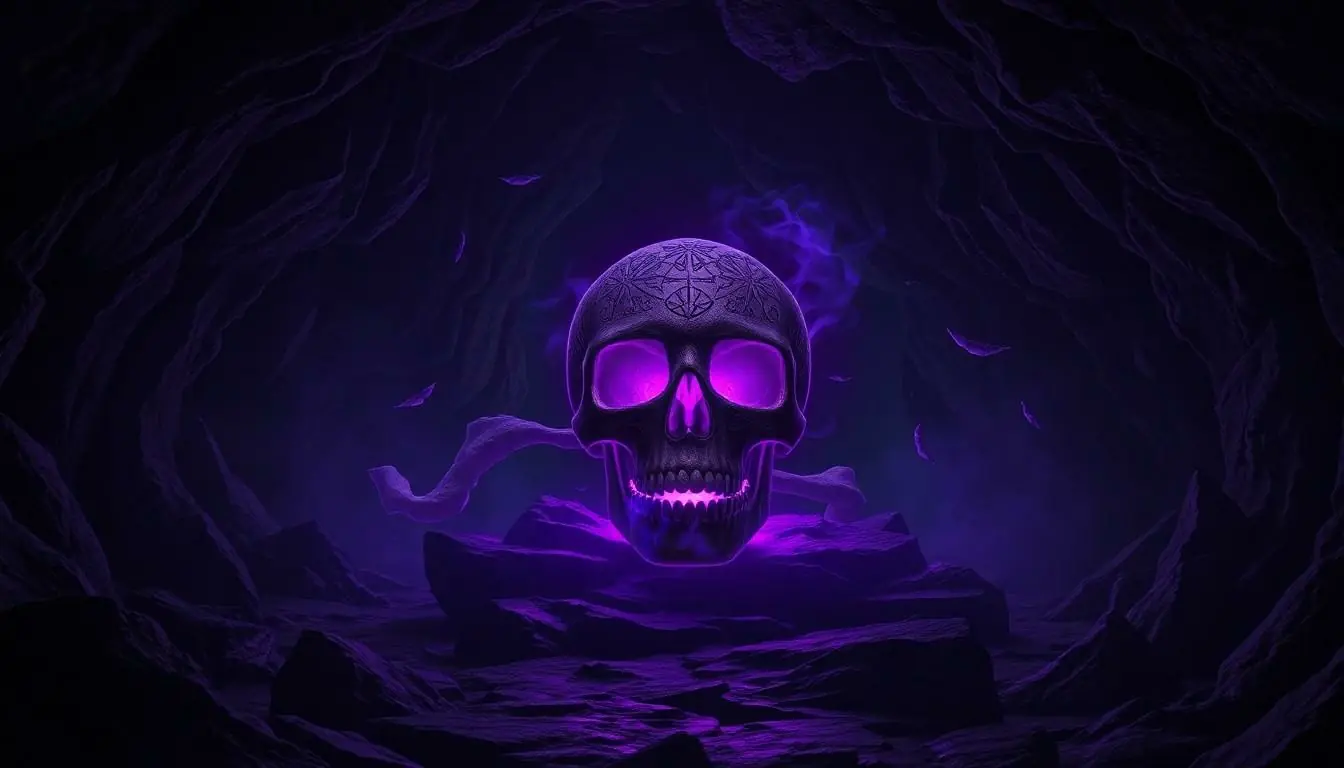In the vast, enchanting world of Skyrim, players often stumble upon treasures that are as rare as they are powerful. One such gem is the Skull of Corruption, a relic that’s as notorious as it is fascinating. Imagine wielding a weapon that not only looks like it belongs in a horror movie but also has the power to manipulate the very fabric of dreams. Sounds like a plot twist straight out of a fantasy novel, right?
Table of Contents
ToggleOverview of Skyrim Skull of Corruption
Skull of Corruption serves as a significant artifact in the lore of Skyrim. This unique staff, associated with the Daedric Prince Vaermina, embodies the power to manipulate the minds of enemies. Players acquire the weapon during the quest “Wake Up,” where its potential unfolds.
Visual characteristics captivate players from the start. The skull features dark, jagged edges and glowing teal eyes, enhancing its menacing presence. Intriguingly, the staff creates dream-based illusions and can inflict damage on opponents while restoring health to the wielder.
Using the Skull of Corruption requires strategy and foresight. When enemies fall under its influence, they face psychological torment reflected in dream manipulation. Damage increases with the number of foes affected, making it a tactical asset in challenging battles.
Its historical significance resonates within the game’s narrative. The artifact first appeared in “The Elder Scrolls: Arena,” showcasing its longstanding role in Tamriel’s lore. Citing its origin, players understand how it evolved into a tool of darkness that affects various realms.
Beyond combat utility, the Skull of Corruption also holds a symbolic meaning. It embodies the eternal struggle between dreams and nightmares, a recurring theme in Vaermina’s domain. Engaging with this powerful relic offers insights into the deeper aspects of Skyrim’s universe, enriching the gameplay experience.
Ultimately, the allure of the Skull of Corruption stems from its dual nature as both a weapon and an embodiment of deeper themes. This central artifact remains a memorable element for players navigating the intricate landscapes of Skyrim.
Lore and Background
The Skull of Corruption plays a pivotal role in Skyrim’s rich lore. This artifact, associated with Vaermina, the Daedric Prince of Dreams and Nightmares, carries a history that extends beyond mere weaponry.
Origins of the Skull
Origins trace back to the enigmatic realms of Tamriel. Legends suggest Vaermina forged the skull from the dreams of mortals, transforming their fears and ambitions into a tangible entity. The artifact appears in various texts, marking its significance in the ongoing struggles between the Daedric forces and mortals. Several accounts describe its ability to embody nightmares, thus symbolizing the eternal conflict between light and darkness. Through these origins, the Skull of Corruption reflects the complexities of elemental forces in Skyrim’s universe.
Connection to the Dreamstride
The Dreamstride serves as a crucial thematic element alongside the Skull of Corruption. This powerful ability allows users to traverse the myriad dimensions of dreams and nightmares. Wielders of the Skull can manipulate dreams to inflict psychological and physical torment on their enemies. By tapping into this connection, players engage in battles that blend reality with the surreal nature of dreams. Experiences in Dreamstride heighten the intensity of encounters, emphasizing the strategic nature of utilizing the Skull. Thus, the combination of these elements deepens the lore, showcasing an intricate relationship between the artifact and the world of dreams.
Gameplay Mechanics
Skull of Corruption offers unique gameplay mechanics that enhance combat and strategic planning in Skyrim.
How to Acquire the Skull
Players obtain the Skull of Corruption during the “Wake Up” quest. This quest unfolds within the Dreamworld, where they confront challenges that test their skills. Completing the quest requires defeating the quest’s final adversary, allowing access to the powerful relic. After successfully navigating through the Dreamworld, he or she can claim the skull as a reward. Exploring this quest deepens the understanding of the lore surrounding the artifact.
Powers and Abilities
The Skull of Corruption manifests several potent abilities. Its primary function allows players to create illusions that confuse opponents, boosting tactical advantages during battles. Inflicting damage scales with the number of enemies affected, making it crucial in scenarios with multiple foes. Additionally, the staff restores health to its wielder, creating opportunities for sustained combat. Leveraging Dreamstride, users can explore dreams and nightmares, further emphasizing strategic use. This duality enriches the combat experience, offering unique engagement in Skyrim’s diverse battles.
Strategic Uses in Gameplay
The Skull of Corruption proves invaluable in various gameplay scenarios. Players can leverage its unique abilities to enhance their combat experience in Skyrim.
Best Character Builds
Optimal character builds for utilizing the Skull of Corruption focus on high Intelligence and Willpower. Mages or hybrid classes often benefit the most from its dream manipulation and health restoration capabilities. A stealth-based rogue can also utilize the Skull effectively, as its illusions confuse enemies during ambushes. Prioritizing perks in Destruction and Illusion Schools amplifies damage output and enhances crowd control. Players should consider maximizing skill levels in these areas, ensuring they can exploit the Skull’s full potential during challenging encounters.
Tips for Effective Usage
Effective usage of the Skull of Corruption relies on strategic planning. Always target multiple enemies as its damage escalates with each additional foe affected. Using the staff in cluttered environments maximizes its impact, allowing illusions to misdirect and debilitate enemies. Timing plays a crucial role; activating the Skull during intense battles can turn the tide in the player’s favor. Health restoration benefits provide a substantial advantage, especially when facing formidable opponents. Players should experiment with positioning, creating scenarios where the staff can shine the most in chaotic combat.
Comparisons with Other Artifacts
The Skull of Corruption stands out among other artifacts in Skyrim due to its unique abilities. While many weapons focus solely on physical damage, this relic manipulates dreams, offering psychological advantages in battles. Other notable artifacts include the Mehrunes’ Razor, renowned for its potential to instantly kill opponents. In contrast, the Skull enhances combat through crowd control and health restoration.
When comparing the Skull with the Wabbajack, another Daedric artifact, distinct differences emerge. The Wabbajack randomly transforms enemies, introducing an element of unpredictability. The Skull, however, creates illusions that confuse foes, maintaining a level of strategy in its application. Both artifacts reward players who adapt their play style, yet they cater to different combat approaches.
Artifacts like the Ring of Hircine provide powerful transformations, offering physical strength and beastly abilities. The Skull complements mages and hybrid classes, rewarding those who prioritize magic builds. Players utilizing the Skull may find themselves executing complex strategies, whereas melee-focused characters may rely more heavily on strength-enhancing artifacts.
Focusing on mastery, the Spellbreaker provides a unique defensive option against spellcasting foes. Comparatively, the Skull requires careful timing and positioning to maximize its potential, especially during intense encounters. While Spellbreaker deflects spells, the Skull turns dreams into a weapon, engaging players in a psychological game.
Engagement with the Skull of Corruption transforms the combat experience, especially for those prepared to blend magical prowess with tactical awareness. Its allure captivates players, intertwining lore with gameplay mechanics that underscore the ongoing conflict in Tamriel’s rich narrative tapestry.
Conclusion
The Skull of Corruption stands out as a remarkable artifact within Skyrim’s rich lore. Its unique abilities not only enhance combat but also deepen the player’s experience through psychological warfare. As players navigate the Dreamworld and face formidable foes, the strategic advantages offered by the Skull become apparent. This relic embodies the intricate relationship between dreams and nightmares while serving as a testament to the creativity of the game’s design. With its storied history and tactical prowess, the Skull of Corruption remains a compelling choice for adventurers seeking to wield a piece of Tamriel’s dark legacy.


